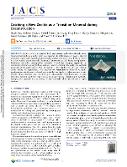Catching a New Zeolite as a Transition Material during Deconstruction

Autor
Steciuk, Gwladys
Palatinus, Lukáš
Datum vydání
2023Publikováno v
Journal of the American Chemical SocietyRočník / Číslo vydání
145 (16)ISBN / ISSN
ISSN: 0002-7863Metadata
Zobrazit celý záznamTato publikace má vydavatelskou verzi s DOI 10.1021/jacs.3c00423
Abstrakt
Zeolites are key materials in both basic research and industrial applications. However, their synthesis is neither diverse nor applicable to labile frameworks because classical procedures require harsh hydrothermal conditions, whereas post-synthesis methods are limited to a few suitable parent materials. Remaining frameworks can fail due to amorphization, dissolution, and other decomposition processes. Nevertheless, stopping degradation at intermediate structures could yield new zeolites. Here, by optimizing the design and synthesis parameters of the parent zeolite IWV, we "caught" a new, highly crystalline, and siliceous zeolite during its degradation. IWV seed-assisted crystallization followed by gentle transformation into the water-alcohol system yielded the highly crystalline daughter zeolite IPC-20, whose structure was solved by precession-assisted three-dimensional electron diffraction. Without additional requirements, as in conventional (direct or post-synthesis) strategies, our approach may be applied to any chemically labile material with a staged structure.
Klíčová slova
electron-diffraction tomography, germanium, crystallization
Trvalý odkaz
https://hdl.handle.net/20.500.14178/2074Licence
Licence pro užití plného textu výsledku: Creative Commons Uveďte původ 4.0 International







